Enemy licking its wounds: How Ukrainian Armed Forces defended Kupiansk and where breakthrough planned
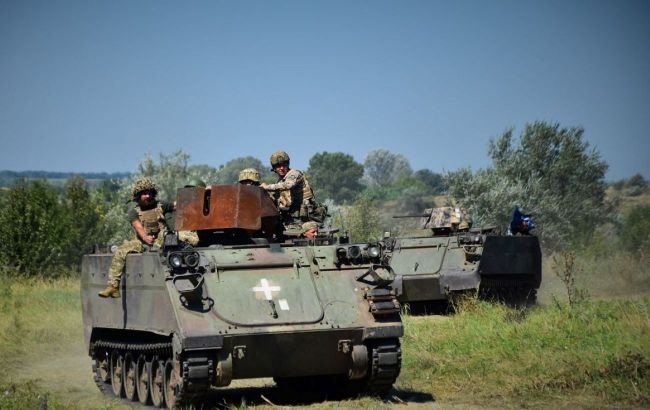 Ukrainian troops are breaking through in the south and expanding their footholds (Photo: t.me/ua_marines_36brigade)
Ukrainian troops are breaking through in the south and expanding their footholds (Photo: t.me/ua_marines_36brigade)
Ukrainian forces are breaking through the Russian defense and are close to achieving another tactical success in the south. Furthermore, their strategic aviation unexpectedly came under attack. For more details on this and the situation on the entire front read the article by RBC-Ukraine.
Russia is licking its wounds near Kupiansk and Lyman
That's how Deputy Minister of Defense Hanna Maliar described the situation in the east these days. According to her, in the last two weeks, the enemy has become more active in the Kupiansk and Lyman directions but has not achieved any success so far.
Regarding Kupiansk, combat operations near the city continue. And not just there. They are so intense that, for example, on Sunday, August 20th, the city was under fire all day long. As a result, buildings and cars were damaged, more than 10 people were injured, and thousands were left without gas due to damage to a gas pipeline.
The enemy is trying to advance to the south of Pershotravneve, Synkivka, and to the east of Petropavlivka. The main thing is that all their attempts ended in failure, and they did not advance.
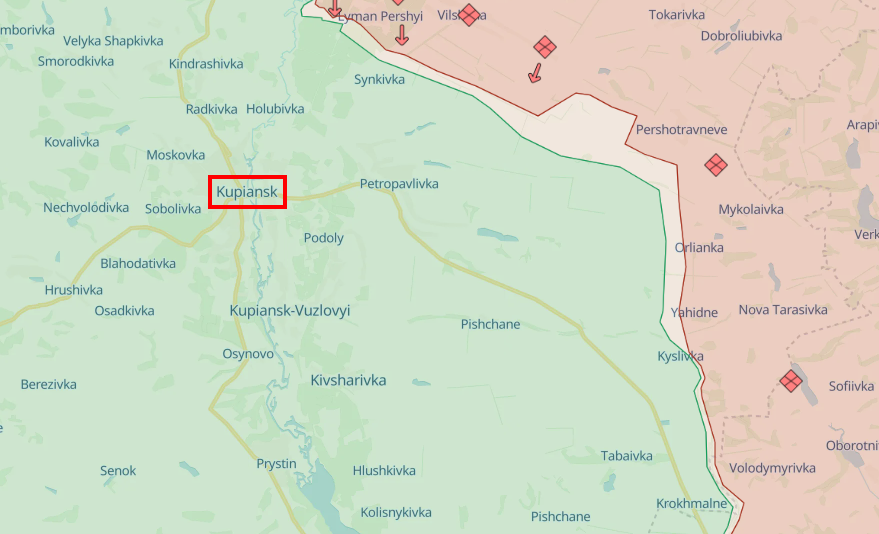
Russians are advancing on Kupiansk to the south of Pershotravneve, Synkivka, and to the east of Petropavlivka (photo deepstatemap.live)
The main battles near Lyman are taking place in the area of Serebrianske forest. Russians are storming positions previously occupied by Ukrainian forces near Kreminna and Bilohorivka (Luhansk region). The defending forces are putting up fierce resistance and repelling the attacks.
"Over the past week, if you look at the numbers, it may seem that the number of shelling and battles has decreased on the Lyman and Kupiansk fronts. But in reality, the enemy is not abandoning its plans. There is simply a regrouping happening, and they are reinforcing their positions," said Hanna Maliar.
She also emphasized that the enemy is licking its wounds, but it does not mean that their activity has decreased for long. According to the General Staff, on August 21st alone, the Russians shelled Dvorichna, Synkivka, Kyslivka, and Berestove near Kupiansk and launched airstrikes and artillery attacks on about 15 settlements in the Lyman area of the front.
The situation is so dynamic that, as analysts at the American Institute for the Study of War (ISW) have noted, Russian sources report their advance several times a day and then retract their statements.
Western partners do not see a threat of a Russian breakthrough. As noted by the Deputy Chief of the Estonian General Staff Mart Vendla, Ukraine's geography is on its side, as the Oskil River and the heights provide a solid basis for defending the northeastern sector.
There is indeed no threat of a breakthrough, but only in terms of the short-term perspective. The reason is the quality of the 100,000-strong Russian group consisting of the "Center" and "West" troops.
"If we analyze the composition of forces and equipment, they have serious problems with their standard staffing. Some units are staffed at only about 30%. Essentially, these are not offensive forces, but defensive, and not the most effective ones," said Oleksandr Kovalenko, a military and political expert for the Information Resistance Group, to RBC-Ukraine.
According to him, attempts to throw unprepared forces into an offensive result in the enemy suffering huge losses. The situation could be rectified with reinforcements, but so far, there have been no such observations.
"Therefore, in the short-term perspective, they will not have the opportunity to break through the defense on the Lyman-Kupiansk axis. Especially in the direction of Kupiansk with the subsequent capture of the city," the expert added.
Russians are trapped near Bakhmut
In the past week, there has been a successful advance of an additional 3 square kilometers on the southern flank of the Bakhmut direction. To the north, the Russians are attempting to dislodge our forces from key heights from which the Defense Forces "give the enemy a hard time."
"The enemy is essentially trapped there. They can't leave Bakhmut and advance properly. They're attempting to storm the northern flank to dislodge our forces. However, the enemy hasn't succeeded in doing so, but the battles there are also intense," said Hanna Maliar.
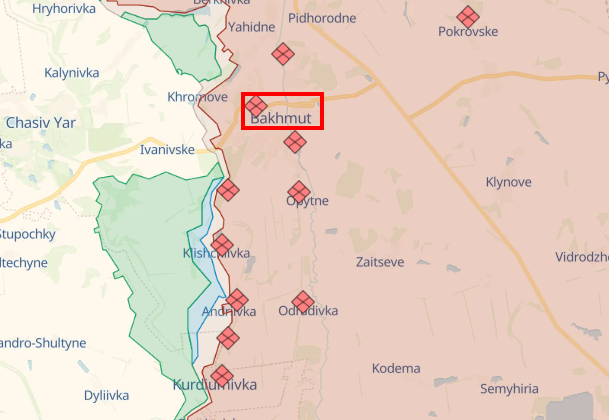
The Defense Forces have taken positions to the north and west of Andriivka on the southern flank of Bakhmut (photo deepstatemap.live)
According to ISW experts' assessments, the limited advance is yielding results. In particular, Ukrainian forces have moved to positions to the north and west of Andriivka, 10 kilometers from the city. Russian attacks to the north of Bohdanivka, near Klishchiivka and Kurdiumiivka, are being successfully repelled.
Regular reports come from there about enemy equipment being damaged. For example, special forces, together with the 30th Brigade, destroyed three artillery guns, the "Strela" anti-aircraft missile system, and a KamAZ truck with FPV drones in six hours.
The operators of the Special Operations Forces group effectively worked on the self-propelled mortar "Tulip" and the self-propelled gun "Pion."
Overall, since the start of the counteroffensive operation on the Bakhmut flanks, 43 square kilometers of territory have been liberated.
They didn't stop after Urozhaine
Last week, the Armed Forces of Ukraine liberated the town of Urozhaine in the western part of the Donetsk region (Berdyansk direction). This was officially announced on August 16th. Judging from the published videos, there is almost nothing left of the town that once had a pre-war population of about a thousand people.
It was also reported that Ukrainian units have fortified themselves on new frontlines, and the enemy is attempting to storm them to recapture the town. However, there is slow but steady progress to the south of Urozhaine. This progress is not only on the right and left banks of the Mokri Yaly River in the direction of Staromlynyvka but also on the flanks with an expansion of the bridgehead.
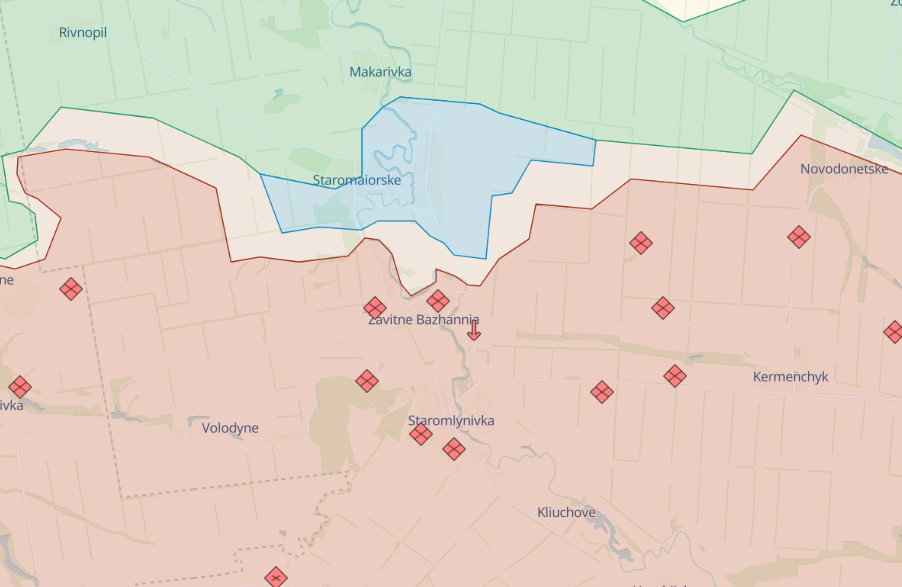
The Ukrainian Armed Forces are moving southward along the banks of the Mokri Yaly River and expanding their bridgeheads (photo deepstatemap.live)
During the moment of success in Urozhaine, there was an attempt to advance southeast toward Kermenchyk, but the enemy managed to stop it. Oleksandr Kovalenko considers the movement toward Kermenchyk logical since it has a dominant elevation. This elevation will allow taking the occupants in Staromlynyvka and its surroundings under fire control.
"The next obstacle is the village of Zavitne Bazhannia. Obviously, we are already in the process of liberating it. Through it, pressure will also be exerted on Staromlynyvka from the side of Urozhayne and Staromykhailivka. At the same time, we will continue to expand the bridgehead - on the eastern flank toward Kermenchyk, and on the western flank towards Pryiutne," he predicts.
RBC-Ukraine has repeatedly reported that Staromlynivka is the main defense line for the Russians. Breaking through it is expected to expedite the advance to the occupied south.
Breakthrough in Robotyne
Another local success in the south is achieved in the vicinity of the village of Robotyne in the Zaporizhzhia region. Battles in this area began in June, but confirmation that our military entered the village only came recently.
According to Deputy Minister of Defense Hanna Maliar, fighters from the 47th brigade entered Robotyne. As of August 22, there was no report of the village's liberation, but it is apparent that this is not far off. It was also reported that Russian occupiers continuously shelled the village.
Experts interviewed by RBC-Ukraine believe that the liberation of Robotyne will change the entire situation in this section of the front. Because the local fortifications remain the main obstacle on the way to the second line of the Russian defense.
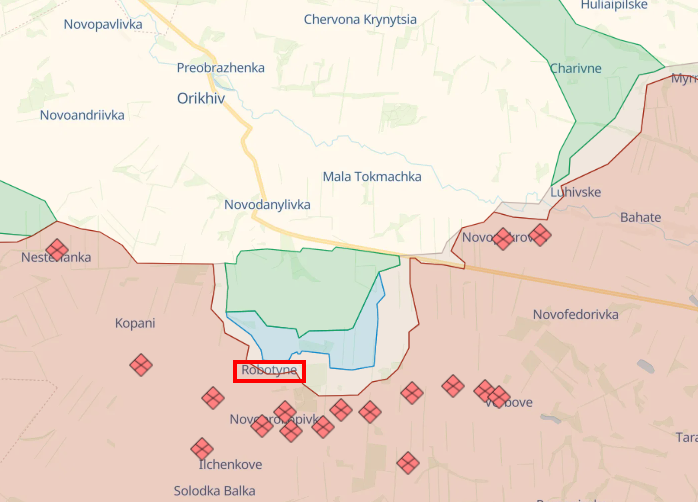
Ukrainian troops are creating wedges on the western and eastern flanks of Robotyne (photo deepstatemap.live)
According to military expert Vladyslav Seleznov, the advance in the Robotyne area is slow due to the high density of mines. But the area must be cleared because it is a key fortified area between Horiachiv and the occupied Tokmak. Beyond it, roads to Berdiansk and Melitopol open up.
"There is a so-called triangle, the mission of which is to close off approaches and the land corridor to Crimea. This triangle is between the cities of Vasilivka, Tokmak, and Melitopol. And when the Ukrainian army breaks through to Tokmak, the entire Russian defense network could be seriously disrupted," he said.
However, before reaching Tokmak, one must pass through Novoprokopivka, Ilchenkove, Solodka Balka, and Chervonohirka. This is already the second line of defense, where the density of minefields is presumably much lower.
Ukraine attacks strategic aviation
Last week was marked by Ukraine's attack on strategic aviation at airfields deep within Russian territory.
Specifically, on August 19, drones attacked the "Soltsy" airfield (Novgorod region). According to Russian Ministry of Defense data, a quadcopter-type unmanned aerial vehicle was allegedly shot down with small arms fire, crashing onto the aircraft parking area, causing a fire that was "quickly extinguished."
It should be noted that the type of UAV indicates it was launched from Russian territory. This base houses Tu-22M3 bombers that launch Kh-22 missiles at Ukraine. Initially, there were reports of minor damage, but soon photos emerged of a fully engulfed aircraft in flames. Western analysts believe that the fire may have damaged two Tu-22M3 bombers.

After the strike on "Soltsy," the Tu-22M3 bomber was destroyed (photo: Russian media)
After the strike on "Soltsy," nine surviving Tu-22M3 aircraft were relocated to the "Belaya" airbase (Irkutsk region) and the "Olenya" airbase (Murmansk region).
Two days later, a kamikaze drone attacked the "Shaykovka" airfield in the Kaluga region. According to Russian media reports, there were no casualties, but another aircraft was damaged. If confirmed, this would be the first instance of two successful attacks on Russian strategic bombers within three days.
According to the BBC's estimates, the destruction of one Tu-22M3 will not significantly impact Russia's air fleet, which has 60 such aircraft. However, the fact itself underscores Ukraine's growing capability to strike deep into Russian territory. According to British intelligence, successful attacks are again raising questions about Russia's ability to protect its strategic assets.
Unlike previous cases, the Ukrainian side almost immediately admitted responsibility for the attacks on the airfields. Andrii Yusov, a representative of the Defense Intelligence of Ukraine, stated in a comment to RBC-Ukraine that the attacks were carried out by groups coordinated by our military intelligence.
According to him, several pieces of equipment were damaged at "Shaykovka." Work is also ongoing in Moscow, Moscow region, and other regions of the aggressor country.
"In many cases, Russian citizens take action for various reasons, including ideological ones, to combat the criminal dictatorial regime," Yusov clarified.
Expert Oleksandr Kovalenko does not rule out that attacks on Russian territory have become so frequent that there is no need to pretend that Ukraine is not involved.
"We see an increasing number of incidents, especially concerning strategic aviation. It seemed that after "Engels" in 2022, there was a pause, and now one airfield after another. Russians seem to be feeling unsafe at their airfields. Of course, they've moved their aviation away, but there are other targets where something could arrive. So, we'll be waiting for new incidents," he concluded.

